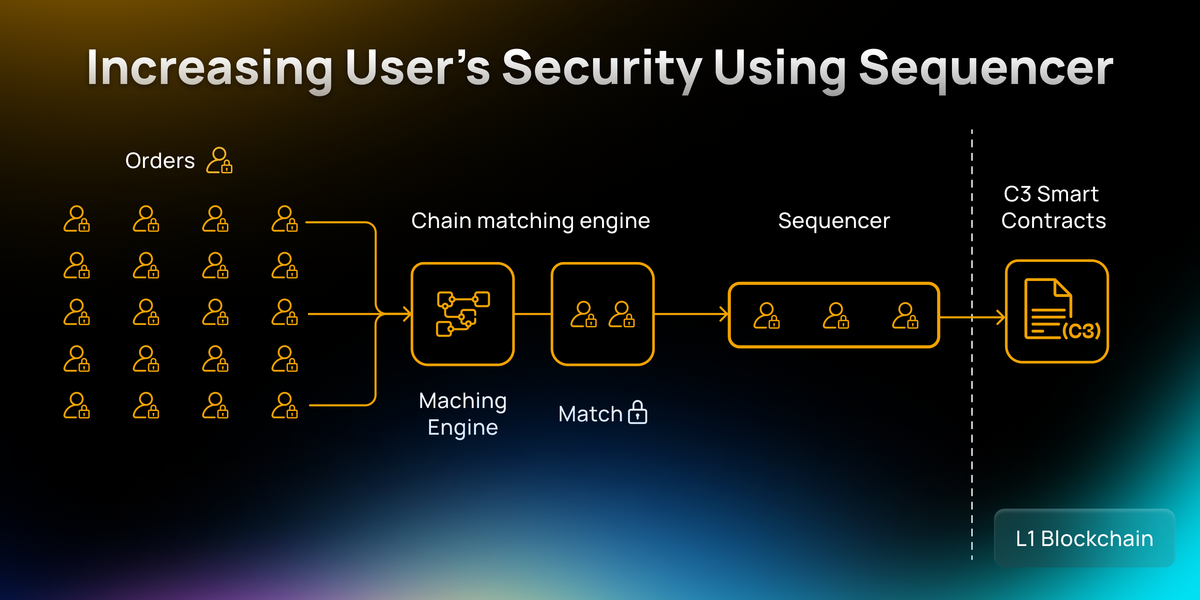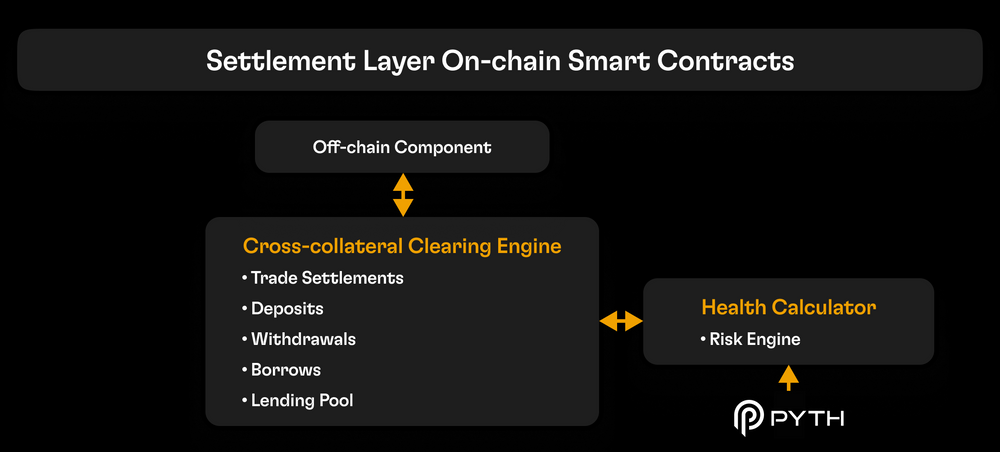Exploring C3's Hybrid Architecture: Increasing User’s Security Using Sequencer

Introduction to C3's Model
As the cryptocurrency exchange landscape evolves, hybrid models are gaining traction, offering a mix of on-chain dependability and off-chain efficiency. The C3 architecture is at the forefront of this movement, utilizing a novel combination of sequencers and smart contracts to streamline transactions and empower security.
The Role of the Sequencer in Off-Chain Components Faster Trade Execution and Reduced Gas Costs
The sequencer in C3's architecture serves as an intermediary layer that receives user instructions and decides their routing—either directly to the smart contracts on Algorand or retained within the sequencer for order matching.
This system substantially reduces the gas costs that are typically incurred when orders are directly processed on the blockchain. By retaining unmatched orders off-chain in the sequencer, C3 ensures that gas fees are only required when orders are matched and executed, thereby reducing the overall transaction cost for users.
Ensuring Privacy and Security
The off-chain component also plays a critical role in maintaining user privacy. Since the sequencer manages order details internally until a match is found, sensitive information is shielded from the public blockchain, enhancing privacy.
Sequencer and Authentications: Dual Roles in Hybrid Exchanges
Understanding Sequencers: Enhancing Efficiency in Blockchain Transactions A sequencer in the context of blockchain and cryptocurrency is a system or component that processes and orders transactions before they are finalized on the blockchain.
It acts as an intermediary layer that collects, organizes, and sometimes batches multiple user instructions into a single transaction that can be processed more efficiently. By doing so, sequencers help reduce congestion and speed up transaction processing times on the main blockchain. They play a critical role in hybrid exchange architectures, where they ensure that operations are not only executed faster but also with reduced costs, since they minimize the number of transactions that need to be recorded on the blockchain itself. This makes them invaluable in scaling blockchain technologies and in enhancing the performance and usability of decentralized applications.
Establishing Trust and Security
In hybrid exchanges such as C3, establishing trust between users and the system is crucial. This trust is achieved through a sophisticated wallet-based authentication process. Users sign messages with their private wallets, which allows the sequencer to confirm their identity without the need for traditional usernames and passwords.
This method not only streamlines the process but also enhances security by utilizing cryptographic proof of ownership.
Furthermore, a secure token is exclusively maintained between the user’s browser and the sequencer, ensuring that no other applications can intercept or misuse this token. This token remains active only while the user’s session is open, adding an extra layer of security during active trading periods.
Authentication Integrity Across Systems
The sequencer’s role extends beyond user authentication; it also ensures the integrity of interactions with the blockchain. By requiring that all commands submitted to the on-chain components are pre-verified, the sequencer acts as a gatekeeper, preventing unauthorized or malicious activities from affecting the blockchain. This is crucial in maintaining a secure trading environment, as it guards against the risks posed by compromised servers. Through this dual verification process, the sequencer confirms that all transactions are not only initiated by legitimate users but also that they adhere to the established protocols before they are recorded on-chain. This comprehensive authentication process safeguards the integrity of the entire system, reinforcing the hybrid exchange’s resilience against external threats and internal vulnerabilities.

On-Chain Components: Authentication and Settlement
Trustless Verification via Smart Contracts The on-chain component of C3 involves smart contracts that execute verified operations. These contracts only process operations that have been authenticated by both the user and the sequencer. This dual-layer verification system is critical in maintaining a trustless environment where no single point of failure can compromise the integrity of transactions.
Role of the C3 Settlement Key
The C3 settlement key is instrumental in the execution and settlement of trades. It ensures that every transaction adheres to the financial validations required by the contracts, thereby mitigating the risk of errors or fraud from compromised servers.
Comprehensive Security Measures and Dual-Layered Protection
Multi-Layered Security Architecture C3's security architecture is designed to assume potential compromise at any point—be it the user, server, or contract. Each component independently verifies the others' actions. For instance, while the server performs initial validations, the smart contracts re-validate to confirm the integrity of transactions. This layered approach ensures that even if one component is compromised, the others can still secure the system.
Proactive Defence Mechanisms
The hybrid structure allows C3 to employ both traditional server security measures and blockchain-specific defences. This dual strategy is crucial in adapting to different types of threats, whether they target the server directly or attempt to manipulate the blockchain operations.
Conclusion: The Best of Both Worlds
C3's hybrid model combines the transparency and trust of blockchain technology with the efficiency and cost-effectiveness of traditional financial systems.
This innovative approach not only enhances user experience by providing faster, cheaper, and more secure transactions but also introduces a robust framework capable of withstanding a variety of cyber threats. Through its sophisticated use of sequencers and smart contracts, C3 is setting a new standard for the future of hybrid crypto exchanges.
